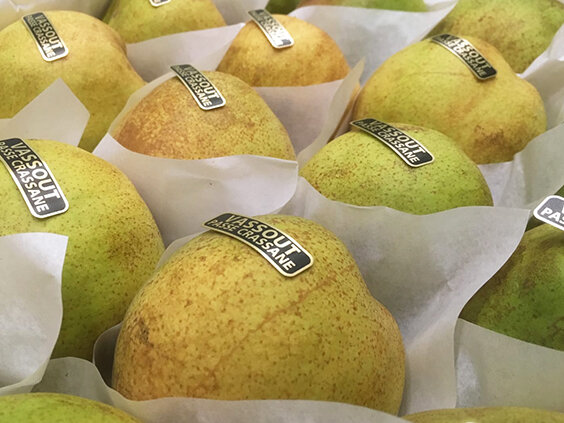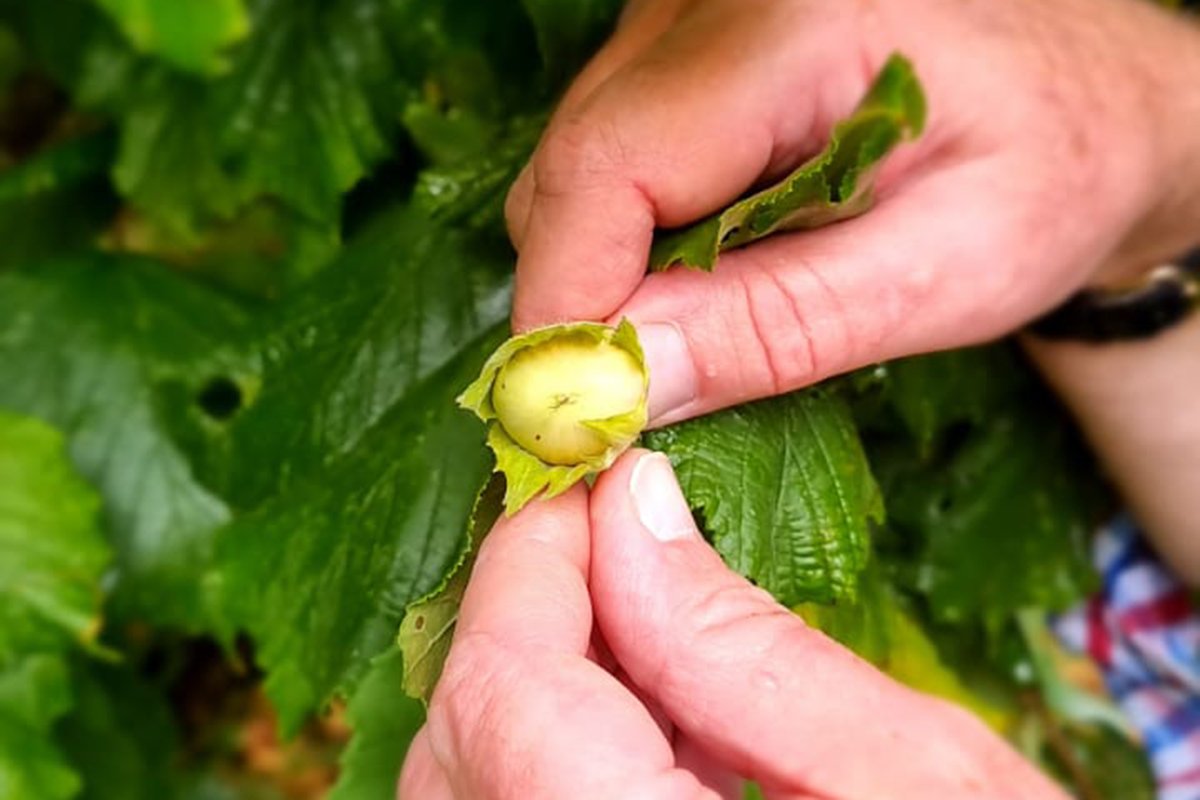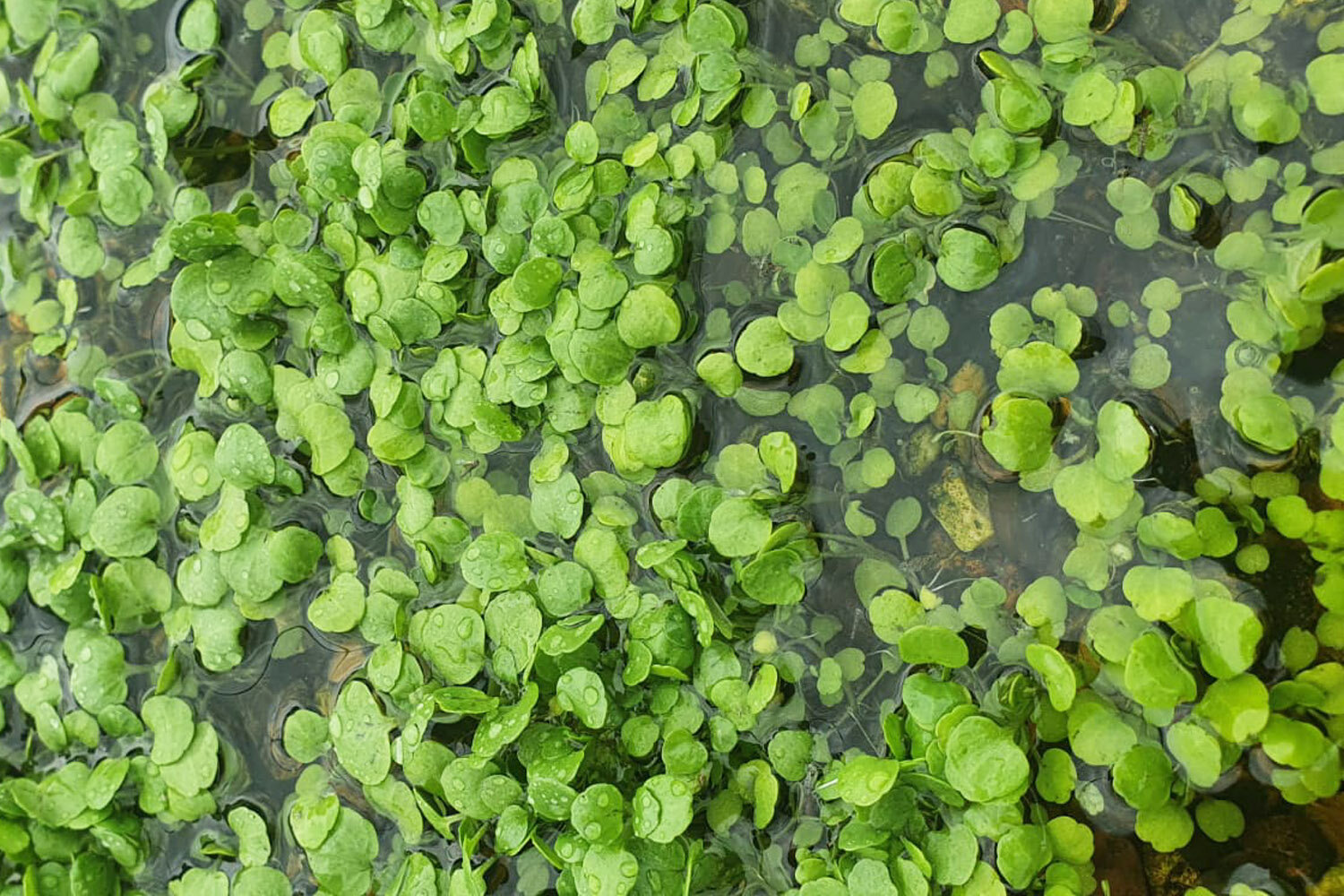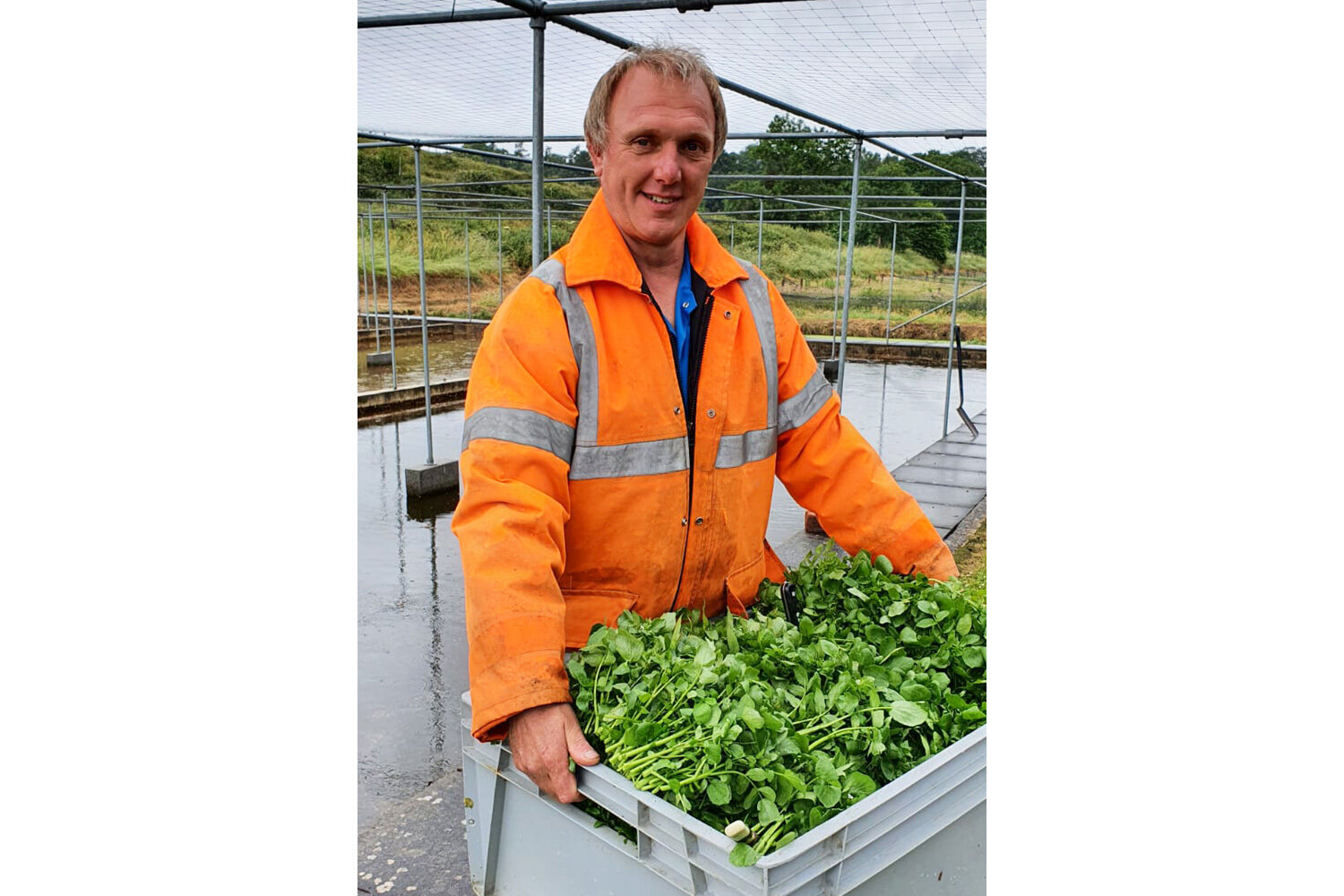Castle Farm
Castle Farm in Kent is the UK’s largest grower of lavender.
Lorna Roberts and Marcus Rowlerson at Castle Farm
Castle Farm has been in the hands of the Alexander family since 1892 and is a few miles north of Shoreham in West Kent. Lorna Roberts (pictured above) is one of three children in the family and kindly gave us a tour.
The farm spans 1200 acres. Crops include arable fields (such as wheat, oats and barley), hops, apples and pumpkins, while cattle roam the water meadows.
The family first planted lavender 25 years ago and it has now become a key crop. In fact, Castle Farm is now the largest commercial grower of lavender in the UK. Lorna explains that if you lined up their hundred acres of plants end to end they would stretch around the M25.
Bunches of Lavandin, which have longer stems than Lavandula angustifolia
There are two key ‘types’ of lavender - lavender and lavandin. The first - Lavandula angustifolia - is the classic lavender with the soporific fragrance. At Castle Farm they grow the varieties varieties ‘Folgate’, ‘Maillette’ and ‘Ladybird’, a variety they bred themselves at the farm.
The second - Lavandin - is a natural hybrid and contains a higher level of camphor, a natural stimulant. Lavandin plants produce more essential oils and are the predominant commercial crop for use in toiletries and cleaning products. At Castle Farm they grow the variety Lavandin Grosso, amongst others.
On the farm, the lavender crop is hand-picked, bunched then dried in kilns for use in interior decoration, but the bulk is machine harvested and used to create lavender essences or distilled for essential oils.
Lavender is increasingly used in professional kitchens and cocktail bars. For chefs and mixologists, lavender essence is sometimes used to flavour desserts such as pannacotta, sorbets and ice cream. Lorna explains that lavandin oil is better suited for working with dark chocolate. Lorna also recommends the pairing of lavender and lemon - a match made in heaven.
Portwood Asparagus
Andy Allen has been growing asparagus in Norfolk for nearly 40 years. “I think we have cracked it now,” he jokes.
Did you know that asparagus is one of the first vegetables in the English growing season?
Up in Norfolk, Andy Allen has been cultivating asparagus for nearly 40 years. In fact, his family has been farming in Norfolk for two centuries. “When I was four or five, my grandmother used to send me out into her kitchen garden with a basket and knife to pick asparagus,” recalls Andy. “That’s how it all started!”
On the Portwood farm, Andy is cropping around 900 acres with 240 of those put down to asparagus. The soil is light and free draining, which is ideal for these plants which have a large root system called a ‘crown’.
From left: Andy Allen and Marcus Rowlerson
The asparagus crowns are planted in ridged beds. Andy mainly uses Dutch varieties. These are either grown from seed on his behalf or he buys one-year-old crowns from ‘crown raisers’ based in The Netherlands.
It takes three years from initial planting until the first crop. “You have to be patient for this job and have a good bank manager,” jokes Andy.
If conditions are right - for example, 10°C at night and 20°C during the day - the asparagus spears can grow up to 10cm in 24 hours. But if the weather turns cold it virtually stops growing.
For an early crop from the start of April, the asparagus plants are protected from wind and frost under small polythene tunnels that are 80cm wide and 50cm high. Andy states: “We are on the shelves and on menus about a month a month before anyone else.”
The majority of the crop is grown in open fields for harvest from St George’s Day, the 23rd of April. The spears are washed then chilled in a hydracooler within half an hour of being cut in the fields, then graded and packed to be in the Market within 24 hours.
Andy stops harvesting the crop on June 21st to allow the asparagus fern to grow and photosynthesise to build up energy in the crown for the following year.
Andy says he loves growing asparagus but is concerned by the current predicament of the farming industry in the UK due to the changes in inheritance tax law for farmers and increases in the expense of labour, which represent 70% of his costs with an asparagus crop. “The whole industry is on a knife edge at the moment,” Andy explains.
You can watch a video of Marcus’ trip to Portwood here on our Instagram.
Polène Tomatoes
For us, the best tomatoes are grown in the soil and sun. For this reason, we work closely with Polène in the South of France.
We always follow the quality and Polène’s soil-grown tomatoes from Provence are the best. This marque is a collaboration between five growers who cultivate five main heirloom tomato varieties alongside 10 smaller varieties including Rose de Berne, Black Krim, Coeur-de-Boeuf, and rarer varieties like Copia and Moya.
Alexandre Ricaud launched Polene in 2021. The farms are run following sustainable principles, including the use of crop rotation, pest control using beneficial insects and soil enrichment using manure and organic fertilizers.
Other crops cultivated at Polene include figs, lamb lettuce, spinach, lettuces, chicories, courgettes and asparagus.
Seuru Leeks
Brothers Thierry and Rodolphe Phillipe grow spectacular leeks in Sarthe on the green belt of Paris using traditional techniques passed down by their father …
The brothers Thierry and Rodolphe Phillipe are based in Sarthe on the green belt of Paris. Their leeks are truly spectacular and cultivated using the traditional techniques passed down by their father. When we asked Philippe what makes his leeks stand out, he explained that they were a product of “good soil and produced with our love.”
Thierry said: “At Seuru, we can’t produce cheaply. We only want to offer the best, taking care of the product to respect nature and the end user. For example we steam wash our leeks and salads. No one does this as it’s expensive to do, but it is best for the product.” I mention these brothers as their fantastic products match our ethos at Le Marché - always following the quality
Bonizzi Rocket
Who grows the best rocket in Italy? Meet the Bonizzi family, who still harvest the crop by hand to ensure superlative quality …
We made a visit to the superlative rocket grower Bonizzi near Verona. The owner is Francesco Bonizzi, 80, who has been growing roquette for over 50 years. His youngest son Andrea assists him in managing the business.
Bonizzi is one of the few growers in Italy still producing roquette by hand - planting, cutting and bunching. This is crucial because many growers use machines to harvest the crop which damages the plant.
A roquette seed planted by Bonizzi will be cut seven times; with machine -ut roquette the plant is damaged by the 3rd cut and won’t grow again. This is particularly important because the 5th and 6th cuts are the best because the plant has matured to have a more intense flavour and defined leaf.
Bonizzi don’t even harvest the first cut! They discard it as they don’t think the quality is good enough to sell.
After the 7th cut it’s allowed to complete its life cycle and produce flowers seed pods. These are eventually cut and then the pods are laid out to dry where they release the seeds which are also dried ready for planting next year.
It’s an expensive way of growing roquette but produces the best quality product. Francesco said he wants Bonizzi to be about quality, not quantity.
Vassout Apples and Pears
Established in 1926, the name Vassout is synonymous with apples and pears of the very highest quality.
Established in 1926, the Vassout family is the oldest family of arborists in Île-de-France, about 50km from Paris. Their name is synonymous with fruit of the very highest quality.
What's truly remarkable is the sheer consistency: immaculate fruit with barely a mark or blemish. The family farm is 35 hectares and run today by Fabien Vassout under the watchful eye of his father Roger Vassout and great uncle Jean Vassout, who have spent a lifetime growing apples and pears.
Apple varieties include Reine de Reinette, Royal Gala, Canada, Fuji, Jubilé, Calville, Clochard, Pink Kiss and Granny Smith.
For pears, it's around 500 tons of Guyot, Williams Blanches, Williams rouge, Beurré Hardy, Comice, Conférence and Passe Crassane.
In the orchards, trees are carefully hand pruned and some leaves snipped away to maximise sunlight on the fruit. The smaller fruit are ruthlessly thinned - leaving fruit that are pretty much perfect.
Mouneyrac
Established in 1928, Mouneyrac is a fourth-generation grower of apples, pears and other fruit in France.
A fourth-generation French grower of apples, pears and other fruit - established 1928. We work with Serge and Jean-Louis Mouneyrac, the current leaders of the business. The quality of their apples and pears is second to none.
The history of Mouneyrac Frères begins in 1928 on a farm in Corrèze with Louis and François Mouneyrac. In 1960, under the second generation led by René Mouneyrac, the company specialised in apples and pears. In 1969, the firm opened a stand at Rungis in Paris. The brothers work with a network of trusted growers and have recently expanded their range to include other summer fruits such as apricots, nectarines, melons and cherries.




Apple varieties include Chantecler, Golden Rose, Patte de Loup, Juliette, Gold Rush and many more…
The photo below shows Serge Mouneyrac (centre) with two of the Le Marché buyers based at Rungis Market.
Mouneyrac Frères say: “We are delighted to collaborate with Le Marché to showcase the excellence of Mouneyrac Frères, sharing our common values for mutual success.”
Potash Farm
Potash Farm in West Kent is a leading supplier of the finest cobnuts - a crop that is now back on the menus of many of London’s leading restaurants.
This beautiful farm in West Kent grows the finest cobnuts, with the harvest starting in August each year. Cobnuts are a type of cultivated hazelnut and now feature of many top menus. “They are the only really fresh nut which are picked and grown in this country at this time of year,” explains Alexander Hunt of Potash Farm.
Marcus Rowlerson from Le Marche with Alexander Hunt of Potash Farm
Demand is booming for cobnuts. “It’s enormous – never been greater,” explains Hunt. This is partly explained by a move to eat less meat and animal fats but must be put in context of a decline in cultivation of cobnuts. Around 7000 acres were cultivated at the turn of the century; this has declined to around 250 acres today. (Fyi, a cobnut orchard is called a ‘plat’.The Kentish cobnut was bred in 1830 by a Mr Lambert of Goudhurst in Kent and is larger in size than a typical hazlenut.)
For chefs, the key consideration is which ‘type’ of cobnut you choose to use. At the start of the season, they are sold ‘wet’ - i.e. freshly picked, with a green husk and a milky and refreshing texture. These green cobnuts have a higher moisture content and a mild flavour. They are picked from mid-August to the end of August and to be eaten as fresh nuts within 6-8 weeks. Try them with a pinch of salt!
The next stage are golden cobnuts - far more versatile in the kitchen. “These are when the green husks start to go to golden – these are picked in September when the green nut starts to turn brown,” explains Hunt.
Golden cobnuts have more flavour that green cobnuts. “Once they are bit more mature they have a woody nuttiness - that is when they come into their own.” Hunt recommends golden cobnuts for salads and other dishes where you might scatter nuts on top.
The final stage is when the cobnuts are dehusked. Dehusked cobnuts are the dried nuts and what Hunt uses for a range of products such as cobnut fudge, biscuits and cakes. They have a very full flavour and can be kept at ambient temperature for up to 2 years.
Minus 8 Vinegar and Verjus
Minus 8 create superlative vinegars and verjus from their lush vineyards situated between two great lakes in Niagara in Canada.
Minus 8 create superlative vinegars from their lush vineyards situated between two great lakes in Niagara in Canada. They are used by many of our chefs and bartenders.
The company has been making ice wines for three generations and turned their hand to vinegars a few decades ago. Minus 8 is the name of their first ice wine vinegar - named after the temperature at which the grapes were harvested and pressed.
There are 12 vinegars and verjus in the range. Grapes are hand-picked at different ripening stages, including at the ice wine stage when the grapes are allowed to freeze. Small batches of grapes are pressed, blended and fine cold filtered.
These products can be used in a huge range of recipes - there’s a small selection below:
Here’s a selection of pastry recipes, too:
The range includes:
Minus 8 barrel aged and blended ice wine vinegar
L8 Harvest fruity and fresh ice wine vinegar
Veget8 tomato vinegar blended with shady Cabernet Franc ice wine vinegar
IP8 hoppy beer and ice wine vinegarConcord 8 grape vinegar
Dehydr8 barrel aged Riesling raisin vinegar
Maple 8 barrel fermented and barrel aged maple syrup vinegar
Apple 8 cider vinegar
Les Cailloux Tomatoes
Les Cailloux in Provence are one of our suppliers of French tomatoes. These days, many growers use hydropnic systems with rockwool or coconut coir blocks. But they grow outdoors, rooted in the soil - and you can tell the difference in the taste ..
Les Cailloux grow their sublime tomatoes the traditional way - outdoors, rather than under glass, and fed by the rich of soils of Provence. (These days, many growers use indoor hydroponic systems with rockwool or coconut coir blocks.) The cultivate around 30 varieties including Red Zebra, Roma, Pineapple and Louna.
Picture credits: Les Cailloux
When an ingredient is this good, it can speak for itself. We know a chef who serves them au naturel - gloved waiters wash and dry the fruit in the restaurant dining room, then serve them whole - at room temperature, of course.
There are several thousand varieties of tomatoes on this planet. We just love the diversity of this ingredient - so many shapes, colours and textures.
Les Cailloux is run by Thierry Boyer. The farm was established by his parents Bertrand and Marie-France. They also cultivate other crops such as aubergines and artichokes.
These are their amazing Zephyr courgettes, another of our favourites. ...
Kingfisher Watercress
Growing watercress since 1854 … that’s quite a heritage. Our grower uses no fertilisers or insecticides - just pure artesian spring water.
Growing watercress since 1854 … that’s quite a heritage. Our supplier Barrie Arminson has spent a lifetime tending his watercress beds in Surrey, fed by artesian spring water and cultivated with zero fertilisers or insecticides.
Authentic watercress is a native British ingredient. Historically, it one was one of the few salads available in the colder months and an essential source of nutrients. It is said that during the Victorian era the public ate one million bunches per day.
Proper watercress is grown in special beds, fed with spring water, where the plant sends down both deep roots and roots that float near the surface. (Land cress, which is grown out of the water, is a far inferior product.)
From left: Marcus from Le Marche, Barrie, and Ben from Le Marche.
The plant is harvested by hand. You use each finger to clamp your cut of watercress until you have a ‘hand’ of cress.
As his website states, as a boy Barrie “learnt everyone had jobs to do, he would winnow the watercress seed while his sister Celia stencilled the company name on watercress boxes and brother Duncan studiously worked in the greenhouses.”
On our recent visit to the farm, Barrie described how decades ago Easter weekend was his busiest time of year. “It was the first holiday most people had off since Christmas … So Easter weekend was very busy with people who wanted to do something. They often had picnics. So what would you buy for a picnic? At that time of year it was only watercress, mustard and cress and celery.”
Barrie remembers filling up the railway carriage with three tonnes of watercress to supply demand in the capital. The steam engine arrived at 3pm on a Friday and took his precious crop direct to London Bridge.
We think this watercress is second to none ….. Fancy a sample? Get in touch.
Beausse Salads
Beausse is a sensational salad grower based 40km outside of Paris. Varieties of baby leaf include orach, yellow chard, purslane and salsola.
Located just 40km outside of Paris, Beausse supplies salad leaves of sublime quality including niche varieties such as orach, yellow chard, purslane and salsola. The family business was established in 1974. The range expanded hugely after trials by Julien, the son of Marc Beausse, who experimented with different varieties and growing techniques - even inventing a bespoke machine to harvest baby leaves in the field.
Credit: Beausse
Beausse is based in Chailly-en-Biere, a region that shares the Paris terroir and has supplied the capital for centuries.
Credit: Beausse
Crops are started under cloches, which are removed once the seedlings are established. This grower only use natural and organic fertilisers. Crops are harvested to order and then hydrocooled - making these the freshest and best salads we know.
Credit: Beausse
Annabel's Strawberries
We are the exclusive London suppliers of Annabel’s spectacular strawberries - picked to our exact specification.
Le Marché was Annabel Makin-Jones’ first customer. Now production is around 500 tonnes per year under the brand name Annabel's Deliciously British.
The strawberries are typically delivered to Le Marché within 18 hours of picking. The key varieties grown are Malling Centenary, Malling Allure and Malling Ace.
Once picked, the fruit is immediately put in a chiller to take the temperature down from 28 Celsius to 2 Celsius in 30 minutes. “It sets the skin so you don’t get the bruising and gives you a longer shelf like,” explains Annabel.
The fruit is grown hydroponically on ‘table tops’ in polytunnels and irrigated with rainwater from a 20-million gallon lake on the farm. There is an apiary on site to provide bees to assist with pollination. Solar panels generate sustainable energy for the office and packhouse.
Packaging is biodegradable - with cardboard punnets - and surplus or misshapen fruit is used to make her range of conserves and sparkling drinks under the brand name Tame and Wild. Other fruit waste is used to power her packaging supplier’s anaerobic digester.
Isle of Wight Asparagus
Meet the Brown family on the Isle of Wight - suppliers of the finest English asparagus.
This month, we are showcasing the asparagus grown by the Brown family on the Isle of Wight.
The flavour is remarkable, with a distinctive character from the salty sea air. All is grown outdoors, rather than tunnels. The farm, blessed by some of the best sunlight levels in the UK, has been run by the same family for 80 years.
The family is constantly trialling new varieties, although some of his fields are still productive after 18 years. Right now, varieties include Gynalim, Backlim, Asplim and Erasmus, a new purple variety. (Here's a fact for you - all varieties with the suffix -Lim have been bred by a Dutchman called Professor Lim, a master of his trade.)
The asparagus is picked early morning - normally before sunrise - then cooled and graded on the ferry to the mainland and with us by midnight.
Here's a photo of the asparagus ferns - the engine room for the plant. They convert sunlight into energy which is stored in the 'crown' or root system of the plant - the fuel needed to fire out the spears which end up in your kitchens.
And the final product? It’s the best around. Frankly, we can’t get enough of it.




















































